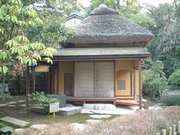Tea house
|
|
Mariko_maison_de_the.jpg
A tea house (茶室, chashitsu lit. "tea room") is a structure designed for holding Japanese tea ceremonies. Tea rooms for tea ceremony are also called cha-shitsu, but they are located within a dwelling. Tea houses in Japan are usually small, wooden buildings and are located in remote, quiet areas or in the gardens or grounds of larger houses.
The design of tea houses is heavily influenced by Zen Buddhist philosophy. A typical tea house is surrounded by a small Japanese garden often featuring a water pool. In the garden there will also be a waiting area for guests, as well as a roji (路地), or "dewy path", leading to the tea house.
The tea house itself is usually built of wood and bamboo, and the only entrance and exit is a small, square door which symbolically separates the small, simple, quiet inside from the crowded, overwhelming outside world, and encourages humility in the host and guests, as all must kneel to enter the room. Tea houses usually consist of two rooms, one used for the preparation of food, snacks and tea supplies, and the other for the holding of the tea ceremony itself. The main room is typically extremely small, often 4 1/2 tatami mats, and the ceilings are low. There is no furniture, except what is required for the preparation of tea. There will usually be a charcoal pit (炉, ro) in the center of the room for boiling water for tea.
Guests and hosts sit seiza style on the floor. There is usually little decoration. There will be a tokonoma (scroll alcove) holding a scroll of calligraphy or brush painting, and perhaps a simple, small flower arrangement called cha-bana (茶花). All materials used are purposefully simple and rustic. All doors and windows are traditional Japanese shōji, made of thin strips of balsa wood covered in a translucent Japanese paper which allows light from outside to come into the room. The floor is built a few feet above the ground in order to keep the room dry. These features are still common not only in traditional style houses and inns but also in ordinary residences.
Tea houses are purpose-built as a place to hold a tea ceremony and each element is arranged with extreme care. The tea house itself can be seen as one of the tools for the tea ceremony.
Tea houses were first introduced in the Sengoku period in Japan, a time in which the central government had nearly no practical power, the country was in chaos, and wars and uprisings were commonplace. Seeking to reclaim Japan, samurai were busy acquiring and defending territories, promoting trade and overseeing the output of farms, mills and mines as de-facto rulers, and many of the poor were eager to seek the salvation of the afterlife as taught by Buddhism.
Tea houses were built mostly by Zen monks or by daimyo, samurai, and merchants who practiced tea ceremony. They sought simplicity and tranquility, which was akin to the values of Zen, in which samurai found salvation and philosophy for their fate.
The acknowledgment of simplicity and plainness, which is a central motivation of the tea house, continued to remain as a distinct Japanese tradition in the later periods.
References
- "Introduction to oriental civilizations: Sources of the Japanese Tradition." Columbia University Press: New York 1958
- Verley, Paul. "Japanese Culture." 4th ed. Updated and Expanded. University of Hawaii Press. 2000
- Murphey, Rhoads. "East Asian: a new History." 2nd ed. Addison-Wesley Educational Publishers 2001

